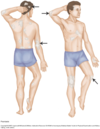Derm Exam - Steve Flashcards
Appendages of skin
hair, nails, sebaceous glands, sweat glands
Dermatologc language
Primary lesion: first recognizable skin lesion
Secondary lesion: evolve from primary lesion due to natural history or disorder (eg crusts in chicken pox) or because of scratching or infection
Distribution: referst to where on body lesions are found (if you have multiple lesions)
Distinguishing characteristics: based on epidemiology, size or associated systemic or lab findings
Hair tyes
–Vellus hair – short, fine, inconspicuous and usually unpigmented (peach fuzz).
–Terminal hair – coarser, thicker and pigmented. Example: - scalp, eyebrows, pubic region.
3 growth phases of hair
–Catagen phase – transitional phase – 3%
–Telogen phase – resting phase – 10-15%
–Anagen phase – Growing phase – 85-90%
What is shown in this picture?

Nail Pits
Psoriasis – Small pits in the nails.
Nail may thicken.
What is this symptom called?

Clubbing – rounding of the
nail. Soft and spongy.
Etiologies:
Congenital
Chronic hypoxia
Heart disease
Lung cancer
Hepatic cirrhosis
What is this deformity of the nail called? What can bring it on?

Beau’s Lines
Emerge from the proximal nail folds, may follow an acute or
chronic illness, chemotherapy.
What is this called?

Mee’s Lines
(longitudinal lines)
Emerge from the proximal nail folds, may follow an acute or
chronic illness, chemotherapy.
What is this condition?

Onychomycosis
Fungal nail.
Name the condition!

Subungual Hematoma
Trauma to the nail.
What causes the following skin colors?
–Brown -
–Yellow –
–Red -
–Bluish-red -
–Brown - Melanin
–Yellow – Carotene, Jaundice (bilirubin)
–Red - Carboxyhemoglobin–(CO poisoning), Polycythemia
–Bluish-red - De-oxyhemoglobin–(cyanosis)
What caused this?

Carbon monoxide poisoning
What are we looking at here?

Jaundice
What are we looking for in the skin portion of the derm exam?
–Color
–Moisture
–Temperature
–Texture
–Mobility and Turgor
–Lesions
What are the affected surfaces? What condition is this typical of?

Extensor surfaces, psoriasis
What are the affected surfaces? What condition commonly presents this way?

Flexor surfaces, atopic dermatitis
What condition is depicted here? What type of skin lesion is this an example of?

Vitiligo
Macule – small flat spot, less than
1.0 cm
Name that skin condition! What type of skin lesion is this an example of?

Café-au-lait spots
Patch – flat spot or lesion greater then 1.0 cm.
Name the skin condition! What type of lesion is this?

Psoriasis
Papule – a raised lesion up to
1.0 cm
What type of lesion is this? What is the classic appearance?

Plaque – a raised lesion greater
than 1.0 cm
Silver look is classic
What is this called? What type of lesion is it an example of?

Dermatofibroma
Nodule – firm, hard lesion, deeper than a papule, greater than 0.5 cm
These lesion questions are legion! What the heck is this? What type of lesion?

Inclusion cyst
Cyst – nodule filled with material, liquid or semi-solid.
Often encapsulated.
What type of lesion is this? What is the condition we are looking at?

Herpes zoster
Vesicles – fluid filled lesions less
than 1.0 cm.
Single or in clusters.
What caused this? What is this lesion called?

Insect bite
Bulla – fluid filled lesion grater
than 1.0 cm.
Name the condition and lesion type!

Urticaria
Wheal – superficial localized raised area of skin.
Blanche with pressure.
Condition and lesion type again…

Pustule – open lesions filled with pus.
Acne
Condition and lesion type!

Ichthyosis vulgaris
Scale – flaking of dead exfoliated epidermis.
Condition and lesion type

Impetigo
Crust – dried residue of skin exudates such as serum, pus or blood.
Lesion type?

Lichenification – thickening of the epidermis and roughing of the skin surface often from rubbing or scratching.
What lesion type? What phenomena is associated with this?

Excoriation – linear erosions caused by scratching.
Koebner phenomena – skin trauma from scratching may cause new lesions
Condition and lesion type?

Tinea pedis
Fissure – a linear crack in the skin
Condition? Lesion type?

Stasis ulcer
Ulcer – a deeper loss of epidermis
What is the pattern shown here?

Linear
Epidermal Nevus
PAttern and condition?

Cluster
Herpes Simplex
Pattern and condition?

Geographic
Mycosis fungoides
Pattern and condition?

Serpiginous
Tinea corporis
Pattern and condition?

Annular
Tinea faciale
What type of pattern is this?

Heliotrope
Over and around the eyelids
The image on the left is a fungus, on the right is herpes. What are the key elements shown in each picture, and what is the test used to identify each?

Fungus
KOH prep of infected skin for fungus
Cellular debris and fungal hyphae
Herpes
Tzanck smear
Multinucleated giant cells
List some key aspects of
•Basal Cell Carcinoma
–80% of the skin cancers
–Arise from the basal layer of the epidermis
–Grow slowly, rarely metastasize
–“rodent ulcer”
List some key points on
•Squamous Cell Carcinoma
–16% of the skin cancers
–Arise from the upper layer of the epidermis
–Can metastasize
What is the ABCDE screening protocol for melanoma?
- A for asymmetry
- B or irregular borders, especially ragged, notched or blurred
- C for variation or change in color, especially blue or black
- D for diameter ≥ 6mm or different from others, especially changing, itching or bleeding
- E for elevation or enlargement
Name that lesion!

Basal Cell Carcinoma
Pearly white, domed shaped papule with telangiectasias.
Center can ulcerate, “rodent ulcer”.
Name that lesion!

Basal cell cancer “rodent ulcer”.
Name that lesion!

Squamous Cell Carcinoma
Commonly found on head, neck or hands.
May develop from a precursor actinic keratoses.
Name the lesion!

Malignant Melanoma

What are these guys? What is the treatment? What concerns should you discuss with the patient regarding this treatment?

Malignant melanoma
Treatment: Usually a deep and wide excision, can be deforming.
What can impetigo lead to?
Kidney problems
What is geographic mycosis fungoides?
Not a fungus… It is actually a T cell lymphoma of the skin.


